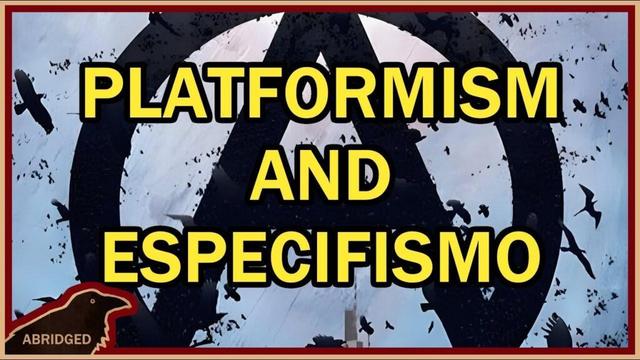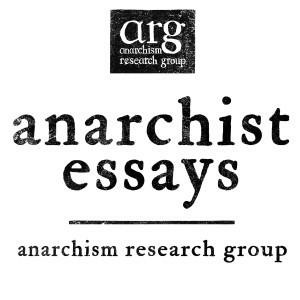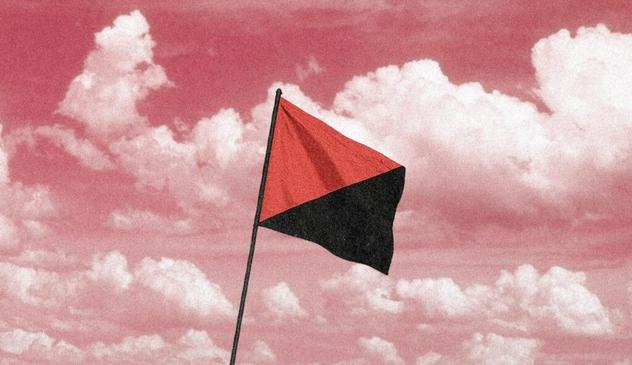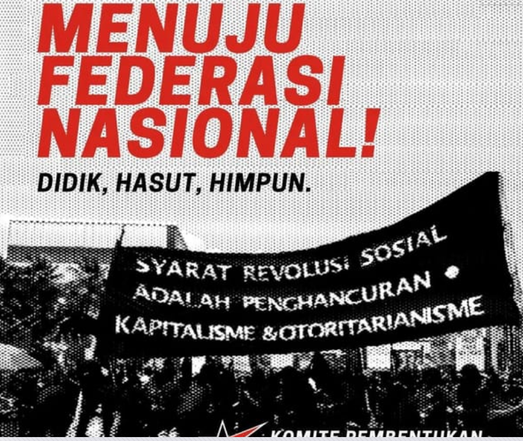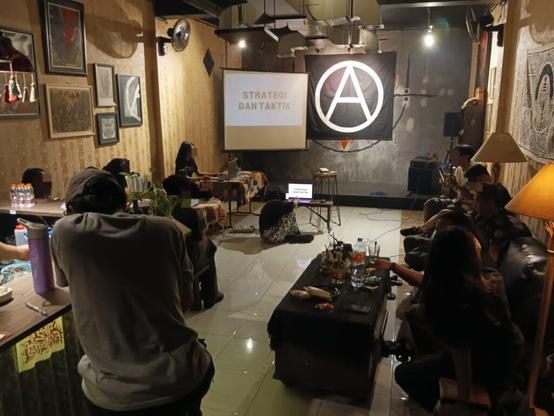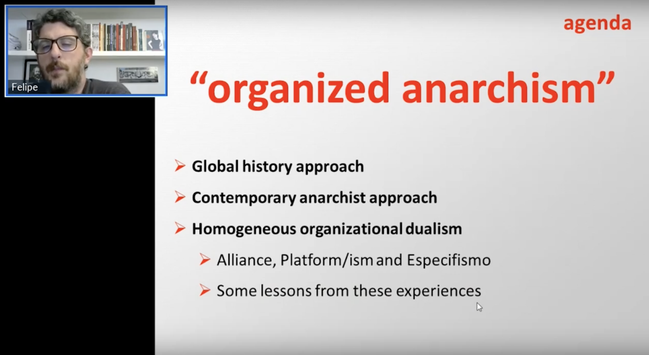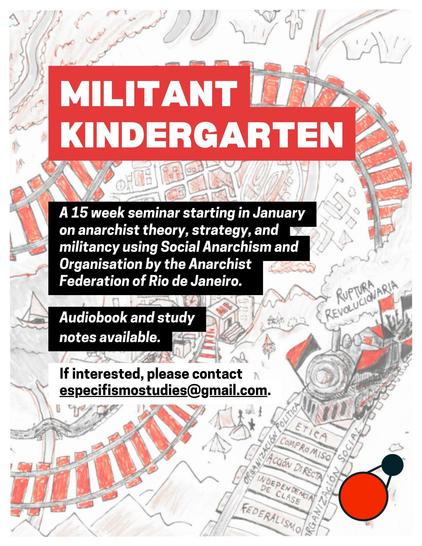Interview on Especifist Anarchism for Ekintza Zuzena
From Regeneración, we’re publishing the interview conducted by the magazine Ekintza Zuzena with a comrade for its 2025 issue (https://www.nodo50.org/ekintza/2025/numero-51-de-la-revista-ekintza-zuzena/), as it reviews the fundamental threads of our movement.
A preliminary question: How would you define and situate the historically known platformist anarchism? And what about specificist anarchism?
I’ll start with some historical notes. First, the Platform emerged in France in the 1920s among anarchist militants who came from Russia. Finally at peace, after a long revolutionary war they couldn’t win, they were able to take stock of their journey as a movement during the Russian Revolution. The Dyelo Truda group (one of those exile groups composed of prominent figures such as Nestor Makhno, Pyotr Arshinov, Ida Mett, Gregori Maksimov, and others) concluded that the cause of the defeat by the Bolsheviks was the lack of organization, program, and discipline of the Russian anarchist movement. They had acted differently in each place. There were never any overall strategic plans or forums to discuss them. The Bolsheviks were able to defeat them city by city, region by region, without putting up a fight on any level other than in Ukraine.
Dyelo Truda proposed a new organizational model: the General Union of Anarchists. This model sought to unify the most active elements of anarchism into a single organization under the program outlined in The Platform. I will clarify that it was not a complete program, but a partial one, as they recognized. The full program would have to be debated within this General Union once it was underway.
This new platformism was highly critical of the “anarchist synthesis,” an organizational model that blended anarchists from all currents of anarchism into a single organization. According to the platformists, the lack of homogeneity of approaches “would inevitably lead to disintegration when confronted with reality.” In other words, it would render the organization ineffective in the face of the major challenges facing any movement. They were extremely critical of anarchist individualism and nihilism (“chaotic anarchism,” they called it). They were also unconvinced by anarcho-syndicalism, since in Russia it had been oriented almost exclusively toward industrial workers, neglecting the peasantry, which was the majority social component in Russia.
So, which anarchist militants were they addressing?
We base our hope on other militants: on those who remain faithful to anarchism, having experienced and suffered the tragedy of the anarchist movement, and painfully seek a solution.[1]
Therefore, they proposed an organization with tactical and strategic unity and discipline. Militants should not join an organization to do whatever they wished, but to fulfill its program. Dyelo Truda intended the Platform to be the revolutionary backbone and meeting point of Russian anarchism, given that at the time they were speaking to exiles, although it would soon be extended to all territories.
These approaches were the reason why the Platform fell out of favor with many militants in other countries at the time, and its development was thus slowed. However, its ideas were the driving force behind the Bulgarian Anarchist Communist Federation, which was strongly present in the resistance to the 1934 coup d’état, in the partisan resistance of World War II, and in the postwar period against Soviet domination, until it was finally liquidated in 1948. These ideas also took root in France, among a sector of anarchism that maintained them from its beginnings until the postwar period. And later, they were promoted again by the Libertarian Communist Federation, with Georges Fontenis as its leading exponent. This FCL greatly influenced European anarchism in the 1950s and 1960s, with the French movement being one of the key movements for anarcho-communism today.
Especifismo, for its part, arose directly from the Uruguayan FAU in 1956. Paradoxically, they didn’t discover The Plafaform until many years later. Their starting point was Errico Malatesta, whose emphasis on specific organization and refutation of individualism caught their attention. Another of their role models was Mikhail Bakunin, who was enormously important to our movement, promoting specific organizations such as the International Alliance for Socialist Democracy. And their other reference point was Uruguay’s earlier specific organizations, organic constructions from the 1920s and 1930s. Thanks to those older militants, who had been in the fray for years, it became clear that the task of political organization wasn’t philosophizing and holding meetings, but rather how to approach the tasks of the different work fronts: union, student, neighborhood, and internal.
Their first task was to create the Organic Charter, in which they situated their organization in the Latin American context of the 1950s and outlined short-, medium-, and long-term plans. The younger militants sought to avoid automatically transferring other plans and formulas that had been used in other historical situations. Their anarchism would have to be rooted in the country and its concrete reality.
This especificism (from “specific” organization) was put into practice alone for years by the FAU until it was also taken up by Argentine groups in the 70s. It must be said that they never contemplated anarchist synthesis because nobody really took this avenue of organization into consideration.[2] The FAU went through different stages and even strategic objectives that brought it closer to the Latin American popular national movement of the 70s, which was in its stage of greatest visibility and size, with numerous social fronts and even its own armed organization, the OPR-33.
In the 1990s, especifismo moved away from these perspectives and began to spread to other countries such as Brazil and Chile. From there, in the 2000s, it began to converge with the anarcho-communist movement typical of Europe and the Anglo-Saxon world, and today it is part of the same international movement.
In Latin America, these organizations do not publicly call themselves Especifistas, but rather “organized anarchism,” which is also the name given to the International Coordinator of the organizations of our movement.
Although we like these models of anarchism, which we understand as the most capable of influencing reality through anarchism, we must clarify that we are neither a Russian, French, nor Latin American organization, so we will have to create a local anarchism, with the makeup of that local anarchism, to operate in the 21st century.
What is your assessment of the current state of the Iberian libertarian movement, and what challenges and needs do you see in your field?
A movement is a set of actions, ideas and efforts organized by a group of people who share common goals to influence society. Starting from this perspective, you will agree that there is no single homogeneous libertarian movement, given that there are no common objectives across this amalgam of individuals, collectives, initiatives, scenes, spaces, organizations, or unions that claim to be anarchists.
Based on this premise, we could first identify a libertarian movement that seeks to achieve libertarian communism. This would be composed of anarcho-syndicalism and some anarchist collectives and organizations, as well as their related social or cultural projects that help them reach a wider audience.
There are also other paradigms similar to libertarian communism but with different characteristics. I’m talking about communalism, democratic confederalism, the anti-capitalist side of cooperativism, a part of autonomy (whether Marxist or indigenist) and similar proposals, or the radical environmental and anti-development movement. These people tend to be fellow travelers of anarchism and, to some extent, even come from its ranks or have passed through its collectives or organizations, but, for whatever reason, they have disassociated themselves from the libertarian movement as we understand it. Therefore, these initiatives cannot be considered part of our movement; rather, they build and participate in others.
Therefore, speaking of the libertarian movement itself, we have a considerable union space—without achieving the strength of yesteryear, of course—made up of the CGT and CNT and all their offshoots (Solidaridad Obrera, CNT-AIT, SAS Madrid, STS-C, and other smaller union groups). This movement has a considerable presence throughout Spain. It’s true that it’s a divided and often inter-struggle union space, which diminishes its potential and contributes to its discredit. It’s also true that for some unions, libertarian communism is such a far-reaching aspiration that it’s not even considered in their current strategy.
If anarcho-syndicalism is the spearhead, there are also organizations or organic initiatives behind it that were founded to contribute to the goal I mentioned earlier. These would be the anarchist synthesis organizations and collectives (this includes what was once called “neighborhood anarchism”), the anarcho-communist ones (currently called “specific,” which seems to be the most popular word right now), and the insurrectionist ones. Their strength is limited to their own members, and their influence extends to the broader spaces in which they operate. We’re talking about some very specific neighborhoods where they operate. Their presence influences the anti-capitalist scene in the places where they operate, and they are generally based in the urban areas and cities of their metropolitan areas (Madrid, Barcelona, Seville, Valencia, Zaragoza, Granada, A Coruña, etc.). And their real impact comes from their militant capacity and commitment. That’s why they have influence.
Next, we have what we can understand as informal anarchism, autonomism, or, as Murray Bookchin would say, “lifestyle anarchism”. We could almost consider it a subcultural scene rather than a political movement, but I don’t deny the interest of many of the people who participate in it in transforming society at its roots. It inherited part of that subcultural component from the Iberian Peninsula punk scene, which so influenced the anarchism of the 1990s and 2000s.
This informal anarchism or autonomism organizes events that can occasionally become massive, such as protests, protest camps or anarchist book fairs, but they generally remain spaces for socializing and networking rather than for social intervention. As a criticism, they run the risk of falling into inbreeding by residing solely on the margins of the social mainstream. In this sector, we can find both people whose goal is libertarian communism and also those who are not interested and seek to live as freely as possible in today’s society.
However, through informal organizations, various networks and coordinators of squatted social centers, libertarian athenaeums, media outlets and counter-information organizations have been launched, and they have participated in other social movements such as anti-militarism, environmentalism and the fight against the globalization of capital.
In Spain, during the 1990s and 2000s, a dualism prevailed: anarcho-syndicalism, understood as a political organization, and informal anarchism, generally anti-organization. This was almost hegemonic, and there was little room for organizational attempts that lasted rather short (the second Autonomous Struggle, Libertarian Alternative, Galician Anarchist Federation, local and regional libertarian assemblies, networks of libertarian athenaeums, and CSOs, etc.). During those years, a peninsular-wide libertarian space was never established, beyond the FIJL linked to insurrectionalism or the FAI, which by 2000 already seemed focused exclusively on libertarian culture.
However, the movement later gained momentum. The youth movement built organizations: the FIJA and the first FEL, as well as some local libertarian youth organizations. Anarcho-independence movements were strengthened with Negres Tempestes in Catalonia, which generated their own momentum. This was a time of heightened anti-development struggles, attracting hundreds of people. Anarchist book fairs proliferated. Anarchist websites such as Alasbarricadas and Klinamen, and other more diverse ones such as Indymedia, LaHaine and Kaosenlared, received thousands of visits; there were still various publications in the form of fanzines, magazines, and newspapers.
From 2010-12, anarchism began to unite, developing in neighborhood or municipal and regional assemblies. This coincided with the period following the 15M movement. In some cases, such as in Catalonia, federations were formed between these groups. But all this lasted only a short time, lasting two, three, or five years, with the exception of some groups that achieved generational change, as was the case with Heura Negra in Vallcarca (Barcelona). Those local libertarian assemblies were the political school for most activists of our time, because there were truly that many groups.
The lack of consolidation of these collectives paralleled the crisis of insurrectionalism as a result of the repressive measures it suffered between 2011 and 2016. But it wasn’t just a repressive issue, it was also a political one. Whatever happened, all of this paralyzed their political project of the Coordinated Anarchist Groups. This crisis demobilized part of their militancy or caused it to drift toward other, more practical projects, and also prevented it from renewing itself generationally.
The most political anarchism, so to speak, was also articulated during that time. For example, Embat in Catalonia, Apoyo Mutuo in Madrid, Aragon, and Seville, Aunar in Aragon, and the Libertarian Student Federation (FEL). We’re not going to lie to anyone: we’re talking about a very small scene that didn’t even manage to become a proper movement, despite our intentions.
Regarding Embat, our analysis of the period after the 15M was that many essentially libertarian ideas and practices had been seen, but they were barely articulated by the libertarian movement. Proposals were taken to town squares individually and embraced by a politically diverse audience. We were aware—we saw them—that in those same squares there were Marxist or social democratic political organizations that had the goal of increasing their own membership. So we understood that it was necessary to have our very own organization to channel that spontaneous libertarian spirit toward a revolutionary perspective. That’s why Embat was born.
During this period, we were able to garner some sympathy, but we failed to attract those libertarian people who were embedded in the social and popular movements. Most of them preferred to continue without a specific organization. This proved fatal with the emergence of Podemos in 2014. Many people who should have been previously organized as anarchists ended up joining the circles and candidacies of Podemos, Ganemos, Sí Se Puede, Más Madrid, or the CUP in Catalonia. Without a strategic line of their own, they adopted social democratic lines until they burned out and went home or until they completely converted to those positions.
Meanwhile, people from libertarian assemblies, insurrectionalist movements or informal anarchism gradually entered anarcho-syndicalism. This time not to turn it into a political organization as in the 1990s, but rather because of labor issues or to help develop some social and cultural area within the unions. They also entered the housing struggle, this time without the intention of “radicalizing the struggle,” but rather as just another actor. Something similar must have occurred in the 1980s with people emerging from libertarian athenaeums.
During those years, 2015-2020, we should highlight the influence of the Federation of Anarchists of Gran Canaria in the libertarian field. Their approach combined elements of social and insurrectionary anarchism under an identitarian anarchist discourse that championed “neighborhood anarchism.” They were also the driving force behind the first Tenants’ Union in the entire state and, at the time, advocated for a rent strike. They managed to bring anarchism to the most disadvantaged neighborhoods of Gran Canaria, reaching a range of people who hadn’t been reached in decades. The FAGC attempted to replicate their neighborhood anarchism elsewhere in the state, giving dozens of talks and writing numerous texts. However, this didn’t succeed and no one on the Peninsula copied his model, which was a shame, since we have always loved anarchism with such strong social roots.
After the 2020 pandemic, we experienced the rise of the GKS/Socialist Movement and its great impact among the youth of the revolutionary left. Anarchism was literally out of the picture at that time, as we have seen. The ambiguous discourse—half Leninist, half autonomous-libertarian—that this socialist movement had in its early days attracted groups of young militants to those areas. Even people who had previously been active in social or insurrectionalist anarchism, which put a good part of our movement on guard.
Consequently, the need to offer an anarchist organizational alternative became clear. Thus, Alternativa Libertaria and Liza were born in Madrid in 2023 (the former later joined the latter), now Hedra in Alicante, Impulso in Granada, the Seminario de Estudios Libertarios Galegos (Galician Libertarian Studies Seminar), and, within synthetic anarchism, the Horizontal network at the state level (although it hasn’t made much headway so far) and some new groups. Libertarian Action of Zaragoza even joined the FAI, a group well established in its neighborhood. Currently, some anarchist assemblies are being re-established in various cities, such as Seville, with that plural or synthetic character that we previously saw in other similar ones. All of this occurs in a context of true growth of anarcho-syndicalism, which has also opened new study centers and cultural organizations.
In short, it has been necessary to offer strong organizations in response to the need of working-class youth to organize. Right now, our entire political space is under construction. Even so, many territories remain with virtually no libertarian entity beyond anarcho-syndicalism, a few propaganda orgs, okupied social centres or music bands.
We are concerned that no assessment has been made of the 2010-2020 decade and that collectives are emerging that uncritically copy the same models that entered into crisis in those years. Because there are not many spaces for interrelation between currents, no kind of collective teaching is being transmitted, a starting point that comrades starting out now can take as a reference. This could be the role of Ekintza Zuzena.
In the summer of 2024, the First Meeting of Especifist Anarchism was held in Catalonia. What need did this initiative respond to, and what is your assessment of it?
The Meeting was a response to previous contacts between the various organizations and groups that exist in Spain and claim to be part of the especifist movement. We intended to draw the attention of this unorganized, but still pro-organizational, libertarian community in the state. That is, those people who now feel the need to have someone supporting them to work politically as anarchists without fearing the other currents of the socialist left.
At that time, about 80 people gathered at the Calafou factory (Vallbona d’Anoia), exceeding our expectations. Many people came who did not belong to the organizing organizations (Batzac, Embat, FEL, Liza and Regeneración Libertaria), and we had some very fruitful discussions with like-minded people from Granada, Galicia, and elsewhere.
During the meeting, a greeting was recorded for Black Rose, our sister organization in the United States, on the occasion of its Convention (something like the annual congress they hold there).
A strong point was the quality of the debate, with very solid arguments. It was also clear that everyone was pulling in the same direction: the need for political organization and social integration—which is to be expected at a meeting of this tendency, but which is not a common occurrence in current anarchism, and that’s why it pleasantly surprised us.
And a weak point was the lack of communicative capacity our movement still has, usually allergic to audiovisual media and with no desire to be the center of attention or make a spectacle of its own everyday life. Admittedly, this demonstrates a modicum of common sense, but I think it’s also positive to make a little noise, to be known and seen.
What groups or initiatives are currently promoting this movement, and what are their goals?
The initiatives currently promoting this movement in Spain are as follows, in order of creation:
– Federación Estudiantil Libertaria (FEL). Emerging in 2008 from several student assemblies in Madrid, Catalonia and Aragon, it was rebuilt in 2014 after a, let’s say, generational hiatus, and has lasted until this year. Its tendency was oriented toward “social and organized anarchism” until recently, when it began to define itself as specific. As student groups come and go quite quickly, it hasn’t managed to consolidate in recent years and now only existed in Catalonia. At the end of last year, it joined Batzac, forming its student front.
– Regeneración Libertaria. A web portal created in 2012 as a space for current analysis, theoretical articles, social studies, and libertarian culture within social and organized anarchism. Last year, given that its current members adhere to the Especifista movement, they decided to put the medium at the service of a common project. So today it is the official portal of the Especifist movement or organized anarchism in the Spanish state. It serves as a link between the organizations that promote it and as a point of debate and exchange of ideas.
– Embat, Organització Llibertària de Catalunya. Founded in 2013 as Procés Embat[3] (like the previous ones, under the paradigm of “social and organized anarchism”) and since 2015 under its current name. It is an organization that has gone through different stages: one of consolidation, acting as a network of activists (2013-15); another of social integration as an organization (2015-19); another very active during the Independence Procés (2017-18), the 2020 hiatus, which was used to create our Political Line[4], and the current era. We are currently active in the areas of housing, education, feminism, eco-social issues, and labor.
– Batzac, Libertarian Youth . Founded in 2017, it organizes young people who, in most cases, have not previously participated in activism. Until now, it had not declared itself a specialist organization, but rather a social anarchist organization. This is due to its interest in achieving specific social integration, as it does in housing, in the student sphere, and in the workplace. It has recently embraced the FEL (Libertarian Student Federation) in Catalonia.
–Liza, Plataforma Organizativa de Madrid. Founded in 2023, it brought together a group of people in need of organization who shared a strategic and tactical vision halfway between platformism and especifism. Its emergence was combined with good online communication and great activity, which enlivened the Iberian scene, resulting in the current semblance of coordination. Its integration is primarily in housing and neighborhoods. It’s also worth highlighting their interest in debating with the rest of the anarchist movement, confronting autonomist and anti-organizational tendencies. Liza absorbed an organizational project called Alternativa Libertaria, which emerged from FEL Madrid.
– Impulso – Granada defines itself as a space for reflection on organized anarchism. Created at the end of 2024, for now, it’s precisely that which defines them: a space for debate and training around the ideas of organized anarchism in Granada. Their intention is to move forward gradually, without skipping steps, until culminating in a political organization.
– Hedra, Organización Especifista de Alicante. This is a recent arrival, having been created in January 2025. It is the first to be created under the label of especifismo, as its theoretical foundations draw directly from the primary texts of this movement. Its integration is in housing and in the neighborhood through a group of associations.
I will also mention the publishing house Teima. Currently working on publishing a book by Felipe Correa, called Black Flag. The publisher will publish texts from our movement in Spanish. However, there are some publishers that publish books in our vein, such as Descontrol in Barcelona or Ardora y Bastiana in Galicia.
In addition to these organizations, which are public, there are other initiatives in other parts of the country that have not yet come to light, and which I won’t mention so as not to jinx them. Some of them come from anarchist synthesis collectives or assemblies that are drifting toward our style of anarchism. By the way, none of them come from Euskal Herria, so let’s see if anyone is interested!
Regarding the stated objectives, the priority is to create a broader anarchist movement with a greater impact on society, bringing anarchism back to the forefront of social struggle.
It’s worth mentioning that we are also coordinating with other European organizations of our same current and with those from the rest of the world. The current international coordination brings together more than twenty organizations, and several more are in the process of joining. The best-known are the Union Communiste Libertaire (French-speaking European countries), Die Plattform (Germany), Anarchist Communist Group (UK), Black Rose Federation (USA), Federación Anarquista Uruguaya, Federación Anarquista de Rosario (Argentina), Coordinadora Anarquista de Brasil (Anarchist Coordinator of Brazil) and Tekoshina Anarsist (Rojava). We are also in contact with other new initiatives currently being created. In some ways, it seems to be a parallel process to that in Spain, which indicates that the anarchist movement is seeking to be better organized.
The concept of popular power has had its greatest diffusion in Latin America, where it has generated significant debate. What is your interpretation or definition of the issue of popular power? How would you differentiate it from left-wing populism?
It was in the 1960-70s that the FAU opted to borrow this concept from the Chilean MIR, the Tupamaros, and other movements of the time that combined various forms of Marxism (primarily Leninism and Guevarism), Liberation Theology, national liberation, and Latin Americanism (those who maintain that Latin America is one country). It should be added that anarchism also influenced this amalgamation, something that is often overlooked. In the 1960s, people’s power replaced Leninist concept of “dual power.”
The Latin American anarchists of the time understood this as logical, since this dual power (those soviets that coexist with the bourgeois state in an advanced phase of the class struggle, once the revolutionary stage has been reached) in turn drew on the ideas of Bakunin.
In the FAU of the 1950s and 1960s, there was a lively debate about the historical subjects who should carry out the revolution. Given the configuration of Uruguayan society at the time, it was necessary to create a subject that would unite all the oppressed sectors of society. The idea of ”the people” was used, but the people were understood as those “below”. They had nothing to do with the bourgeoisie. It was somewhat like when the historical CNT-FAI spoke of “the working people” in their newspapers and manifestos. They didn’t refer solely to the proletariat, since at that time, to ordinary people, it sounded like talk of factories and little else.
In this relationship between ideology and the production of historical subjects—a relationship that, if it didn’t exist, would mean neither ideology nor subject—moments of ideological validity are formed. Historical subjects/agents expand and lead to the hegemony of social bodies, based on the validity of ideologies.[5]
As the class struggle unfolded in Latin America, alliances between the organized labor movement, the student movement, the first feminist associations, the peasantry, and grassroots collectives centered on identity, such as Afros, mestizo, and indigenous peoples, came into play. Furthermore, in the 1970s, the social war received support from the self-employed and small business owners expelled from industrial production. The class struggle often moved to neighborhoods or communities far from the city, and elements of counterpower were generated from below in the midst of the struggle. This was popular power: the people in motion, diffuse, anonymous, contradictory, creative, festive, and combative. Land seizures, industrial cordons, armed groups, occupation of universities—this was popular power in the eyes of ordinary people. In no way should it be confused with interclassism, with its conscious “from below” nature.
In the 2000s, the critique began. The especifist or organized anarchist organizations used popular power in their political language. But Marxist organizations did too. In Cuba and Venezuela, all ministries carried the tagline “popular power.” So the term was also linked to the socialist state. Comrades critical of the concept of popular power also pointed out that anarchism was being abandoned within the especifist ranks toward Marxism or national populism. Some anarchists even went further, denying the adherence to anarchism of our entire movement, viewing it as a crypto-Marxism as a whole. This is the origin of the conflict.
With Embat, it was even comical to see that, during the first few years, certain people would always come to all our talks and say that popular power couldn’t be anarchist in any way. Ironically, we held the opinion that, in reality, everyone understood us perfectly, except for the “most anarchist” ones. No one seemed to have the slightest problem with the Black Power movement of the American Black Panthers, a concept roughly equivalent to popular power.
However, the passing of the years has largely mitigated those debates. If some organizations or individuals drifted toward other ideological positions, the vast majority did not, contributing to the libertarian movement as a whole, and not just to our current in particular. Today, in Spain, this concept has been largely accepted, even by people who come from other currents, such as anarcho-syndicalism or by libertarians who are active in neighborhoods or housing projects without ever having been on our wavelength.
Regarding left-wing populism, we must say that it engages in interclassism, mixing working-class demands with more bourgeois middle-class ones. This would be the main difference. Specificism defends a “strong people” [Pueblo Fuerte] built as a front for the classes oppressed by capitalism and the state. Although we speak of both currents of popular power, there are substantial differences. Let’s see what the specificist view is:
We proclaim the most complete socialization of all spheres of social activity. The socialization of the means of production exercised by the organs of real representation of society and not by the State; the socialization of education, the administration of justice, defense organizations, the sources of knowledge and information, and most especially the socialization of political power. In this last aspect, we advocate the abolition of the State and governmental forms of power as the only guarantee of eliminating all forms of domination. […]
We are fully convinced that this is effectively possible through direct democracy, exercised by grassroots popular organizations organized in a self-managed manner and linked within a federalist framework, where these same popular organizations are expressed in new institutional forms. Today we know more firmly than ever that the model of society we propose is not only possible but is practically, and in accordance with the historical and revolutionary experience of different peoples of the world, the only valid path to truly building socialism.[6]
It would be bold to say this isn’t anarchism.
To what extent can the desire not to remain locked in the [activist/anarchist] ghetto and to participate (with a non-dogmatic discourse) in current social struggles or processes lead to political contradictions with anarchist or basic principles of the society for which you fight? Do you remember any occasions when you experienced this dilemma?
Social processes are complex by nature. There are many forces at play and many vested interests. The challenge is to build transformative collective interests in a democratic, transparent, and fraternal environment.
For Embat, the crucible was 2017. We had to position ourselves in a tremendously complex scenario. The Spanish state was in crisis and Catalan society demanded a response. This was the referendum. In just a few months, we experienced a large-scale process of collective empowerment. In just a few weeks, I’d say. The movement was already underway, but the events encouraged many more people to join the process. Counter-power structures were created, the committees for the defense of the Republic. They operated as assemblies, calling for actions and demonstrations. But they also had the opportunity to be spaces for territorial counter-power. Another initiative worth considering was the Constituent Procés, which proposed a constituent assembly for an independent Catalonia that would accommodate the most advanced social aspects. Social and union movements also joined the process in their own way. They joined and were responsible for the famous general strike of October 3rd, one of the most widely followed in Catalan history. The slogan of blocking transportation—trains, roads, and in 2019, the airport—naturally emerged. Something that had only been theorized about in anti-capitalist debate years before and was dismissed due to a lack of strength was put into practice.
Although we were perfectly aware that the leadership of this entire process was in the hands of the “traditional” Catalan political class, we also saw what was happening below. Our response was that we had to be there. We always felt that much more could have been done if all the social and union movements had acted unitedly and as a bloc. But this would have required a much greater organized anarchism, which is what we are trying to build.
Another complex and conflictive moment in which we had to take a stand was during the pandemic. Embat’s position denounced the police state and the state’s militarization of public spaces, while workers in “essential services” were forced to go to work without sufficient protective measures. We also highlighted the devastating effects of the privatization of healthcare and the management of nursing homes and clinics by private entities. At the same time, we welcomed the self-organized mutual support groups that emerged in many places, as well as the grassroots initiatives in which we participated, such as the Social Shock Plan or the attempted rent strike that was proposed during those months. I would add that we took advantage of the lockdown internally to develop our political line, which required much debate. And during that time, the International Coordination, in which we participated, was also strengthened.
The contradictions were clear within our libertarian movement: some focused on denouncing the police state and the infantilization of people, while others preferred to focus on denouncing privatization and self-organization. We didn’t see a unified approach, and each of us fought a bit of our own battle. Perhaps what united us most was those proposed shock plans and similar ones.
NOTES
[1] This excerpt can be found in the Introduction to The Platform https://www.nestormakhno.info/spanish/platform/introduccion.htm
[2] For more information, see The Strategy of Especifismo. Interview by Felipe Correa with Juan Carlos Mechoso: http://federacionanarquistauruguaya.uy/wp-content/uploads/2017/08/La-Estrategia-del-Especifismo.pdf
[3] Embat in Catalan refers to the crash of a wave against a rock. It sounded powerful and poetic to us, and it seemed a better name than the typical acronyms of other libertarian organizations of our time.
[4] This was when Especifismo was adopted as one of the guiding principles. The Political Line can be consulted at: https://embat.info/programa-i-linia-politica/
[5] Popular Power from a Libertarian Perspective. https://federacionanarquistauruguaya.uy/poder-popular-desde-lo-libertario-fau/
[6]Ibid.
source: Anarkismo
